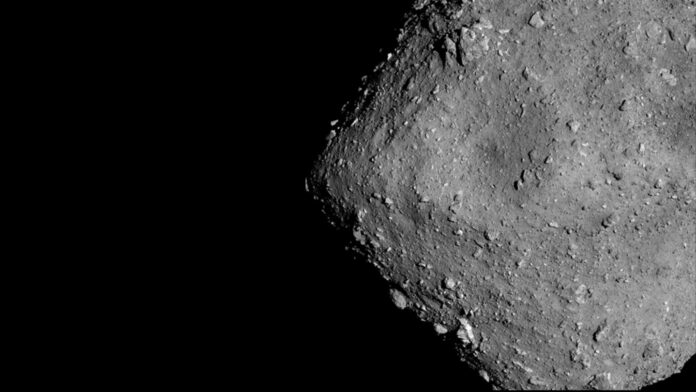In December 2020, the Hayabusa2 spacecraft brought back the samples of the carbonaceous asteroid Ryugu to Earth. Analysis of these samples shed light on the long trek of this cosmic wanderer.
The findings revealed that asteroid 162173 Ryugu began its cosmic journey more than 4 billion years ago and billions of miles away, in the outer part of our solar system. It traveled to us across space, taking in the history of this corner of the universe in the process.
These discoveries are just a part of the findings of an international investigation into surface samples from Ryugu. The Japanese space organization JAXA’s Hayabusa 2 mission meticulously gathered these asteroid dust grains, brought them back to Earth, and then transmitted them to research facilities all around the world. Numerous experiments are carried out on these tiny fragments to try and uncover their composition and possible formation mechanisms for the parent asteroid from which they came.
At its closest orbit, asteroid 162173 Ryugu is only about 60,000 miles from Earth. That’s only a quarter of the distance to the moon.
Argonne Distinguished Fellow Esen Ercan Alp said, “The key contribution of the APS s a particular X-ray technique he and his team specialize in. It’s called Mössbauer spectroscopy — named after German physicist Rudolf Mössbauer — and it is susceptible to tiny changes in the chemistry of samples. This technique allowed us to determine the chemical composition of these fragments particle by particle.”
“What they and their international colleagues found was surprising.”
“There is enough evidence that Ryugu started in the outer solar system. Asteroids found in the solar system’s outer reaches would have different characteristics than those found closer to the sun.”
“The APS found several pieces of evidence to support this hypothesis. For one, the grains that make up the asteroid are much finer than you would expect if it was formed at higher temperatures. For another, the fragments’ structure is porous, meaning they once held water and ice. Lower temperatures and ice are much more common in the outer solar system.”
The diameter of the Ryugu fragments ranges from 400 microns, or six human hairs, to one millimeter. However, the X-ray beam used at beamline 3-ID-B can be focused down to 15 microns. The team was able to measure each fragment numerous times. Across all of the samples, they discovered the same porous, fine-grained structure.
Scientists found a chemical makeup similar to meteorites that have hit the Earth — specifically a group called CI chondrites, of which only nine are known to exist on the planet — they discovered something that set the Ryugu fragments apart. The spectroscopy measurements revealed a huge amount of pyrrhotite, an iron sulfide that is nowhere to be found in the dozen meteorite samples.
Argonne physicist Michael Hu said, “Our results and those from other teams show that these asteroid samples are different from meteorites, particularly because meteorites have been through fiery atmosphere entry, weatherization, and in particular oxidation on Earth. This is exciting because it’s a different sample, from way out in the solar system.”
The report describes the multi-billion-year history of 162173 Ryugu using all available data. It once belonged to a much larger asteroid that originated around 4.5 billion years ago, 2 million years after the solar system. It was formed of various substances, including water and carbon dioxide ice, dissolved over the following three million years. This produced a surface that was dryer and a hydrated inner.
This asteroid was hit by another space rock around a billion years ago, which caused it to fragment and launch debris into space. Some of these pieces eventually came together to form the Ryugu asteroid that we see today.
Alp said, “For planetary scientists, this is first-degree information coming directly from the solar system, and hence it is invaluable.”
Journal Reference:
- T. Nakamura et al. Formation and evolution of carbonaceous asteroid Ryugu: Direct evidence from returned samples. Science. DOI: 10.1126/science.abn8671
